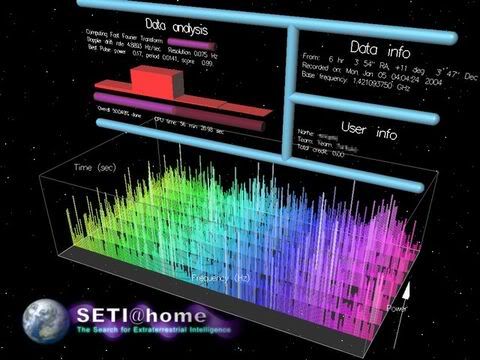http://www.grid.org/home.htm
First Some Background
Many years ago I downloaded a small unobtrusive program associated to the Search for Extra-Terrestrial Life (SETI) Project. The program remains resident in your systems memory using spare CPU cycles when it can, without really making itself a nuisance.

The small program doesn't slow your computer down in any noticable way. It automatically downloads small encrypted data files from SETI@Home, then runs the data through various processing, and then uploads the results back to SETI@Home. The program is designed to identify radio signal patterns which are deemed intelligent in design, and the result of technology. The data is collected from a radio telescope in Puerto Rico which collects large amounts of data that would otherwise take decades to process using even very fast computers.
The SETI@Home "Grid" consist of millions of computers, such as mine, which have been put to use to assist in the number crunching. These computers collectively form a parallel processing grid which has contributed millions of cpu hours effectively allowing the SETI@Home project to scan vast amounts of radio signal data in a short period of time. If your computer is the one(s) which helps to find extra-terrestrial life SETI has promised to include you in any presentation ceremonies for the Nobel Prize which would surely result due to the discovery.
The Grid
The idea of parallel processing isn't new, but SETI@Home was one of the first such projects which employed the vast untapped computing power available only since the development of the Internet. SETI@Home's success directly led to the development of a company called United Devices.

United Devices has developed a flexible platform for research facilities which need vast amounts of computing power on the cheap. The solution? The GRID, which is based upon the same approach as the SETI@Home project, as it depends upon millions of volunteers to install United Devices' distributed processing software.
Like the SETI@Home software United Devices' GRID software is unobtrusive, uses spare CPU cycles so you don't notice a system slowdown, and cost nothing. It has a screensaver mode, and it will graphically display the part of a molecule your computer is working on - which is neat for all you chemistry geeks out there!
Past, and ongoing GRID projects include assisting in the development of a treatment for smallpox. The treatment should not be confused with the smallpox vaccine which already exist. The GRID was assisting in the development of a drug which would be used to treat people who already have smallpox. Since smallpox has been irradicated you might wonder why a need for such a treatment? The project was associated with the department of defense in the fight against bio-terrorism.
There's also an ongoing GRID project seeking to identify best candidates for drugs suitable for treating cancer. Most recently, a new project has been added which is assisting in research on the function of human genes. This too will assist in developing drug treatments for any number of human diseases.
While United Devices is a for profit company, the GRID is a non-profit project associated with Oxford University.
For those skeptics out there, this is real world science, not fringe science. The results of these projects are slicing decades off of research time in helping to develop suitable drugs to treat diseases which afflicts millions.
I invite everyone reading this post to check out the GRID website. Dave at The11thHour did over a year ago, and I haven't heard any complaints yet!
There's even an incentive program, which I've never really looked into because I don't care about trading in "points" for prizes - I just wanted to cure cancers!

1 comment:
It is called 'distributed computing' and the other day I read an article comparing one of IBM's top supercomputers to a conservative estimate of SETI@Home's processing ability. SETI@Home had the ability to process almost 1 and a half times the amount of data as the supercomputer could.
Post a Comment